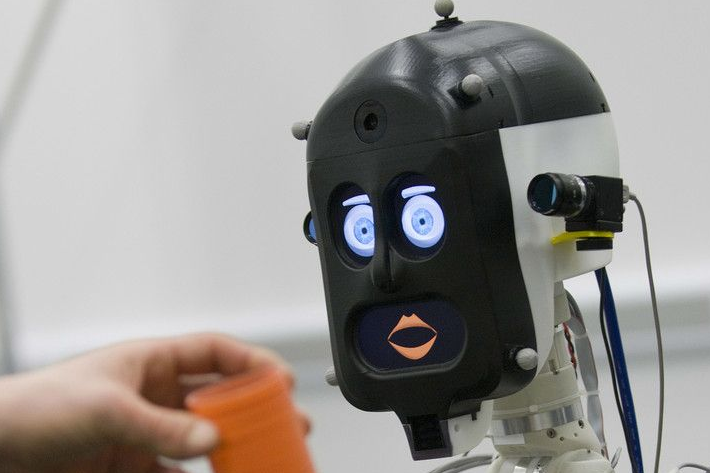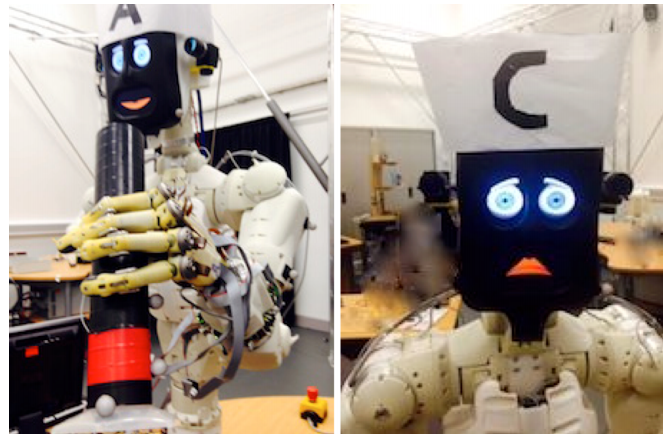Editor's note: From mythological stories to science fiction novels, humanoid robots have long existed in our imagination. And when the humanoid robot really enters our lives — we find ourselves feeling passionate about it. For robots that can "express emotions", we are really not immune. Will you lie to it without letting a robot "sad?" If you also participated in an experiment at the University of Bristol and London College, the answer is yes. Robot apologizes and humans are not resistant In this robot-assisted experimenter's egg cake experiment, a humanoid robot named Bert (BERT) handed eggs, oil, and salt to the person who made the pie. Ucl In this series of controlled experiments, the experimenter and the two groups of robots were together, one group was a robot with no communication function (the left in the figure below), and the other group was a robot with a constant error, but it could be their own Errors constantly apologize and can even change facial expressions depending on the scene—joy, sadness, or shock (right). At the end of the study, the experimenters will answer whether they would like to give the robot full-time kitchen assistant position. The results of it? Most robots prefer to work with an inefficient but more expressive robot than a robot with a cool face but perfect work. Adriana Hamacher is the lead author of this research paper, which is part of her study at the London College School for a master's degree in human-computer interaction science. She told Digital Trend: "I didn't think so many people would want to interact with Burt. People were really very sensitive. When Bert couldn't catch the eggs, they also helped it. Some of the experimenters kept giving him advice and encouragement. There were still some shocking things that I never thought of when Bert asked if it had gotten this kitchen assistant job. According to the request, the tester could not negotiate the refusal, but only answered Yes or No. This would make the experimenter feel uneasy. "." The experimenter sees the robot's apologetic expression In fact, it is not new that people are easily impressed by communicative machines. In the 1960s, Joseph Weizenbaum, a computer scientist at MIT, imitated psychotherapists and programmed a basic version of the chat robot ELIZA. Although ELIZA simply repeated the previously stored information in the form of a question, it triggered the tester to reveal his true feelings, which surprised programmer Weizenbaum. Planet-source-code For example, in the late 1990s and early 2000s, the Phoebe Wizard, a furry owl-modeling robot, was quite popular. The Phoebe Elves can play games with the owner, and they can also tell the owner the fictional Phoebe. After a while, Phoebe could use his master's English words to partially replace his fancy Phoebe words. It looked like he had learned English from his master. However, in fact, the Phoebe Wizard does not really have such ability, but it still makes people feel very shocked. Stuffedparty Why do we cling to humanoid robots? This problem is actually quite understandable: At both the emotional and intellectual needs, we are always trying to build humanoid robots. Just as AI pioneers who like logic and chess think that artificial intelligence should include the logic of chess gameplay, it's reasonable to use machines to imitate us. In fact, the idea of ​​manufacturing humanoid robots already exists: In ancient Cyprus, there was a king named Pygmalion. He was dedicated to carving and devoted himself to carving a woman with ivory. In the end, the love of God Aphrodite was moved by it, giving life to the statues and making them married. The famous "Pygmalion effect" is traced back to this. In ancient China, there was also the legend of “Guru’s offering techniquesâ€. It is said that in the Western Zhou Dynasty there was a mechanical engineer named Yanshi, who presented a lifelike robot to Zhou Muwang. Over the years, such ideas have also permeated various robotic projects. For example, the world's first multipurpose mobile robot, Shakey, was developed at the Stanford International Institute in the late 1960s. It is the first mobile robot to use artificial intelligence and can infer the appropriate actions to take. The robotics industry is changing in the same way as the artificial intelligence industry. Many promising robots do not try to imitate all human actions. Commonly used industrial robots are far from humans, but this does not mean that the idea of ​​humanoid robots will become obsolete. On the contrary, the goal of creating a humanoid robot is gradually clearer than using simple logic to solve the problem of motion or fine motion control. For example, robots in the medical field, if they have appearances like others, will promote people's openness and empathy. In addition, humanoid robots can also produce a "wrong" emotional connection. Earlier this year, California researchers reported that touching the buttocks or groins of a robot allows the tester to sexually arouse, suggesting that future "sex robots" will maintain a distinct human form. But everything is a double-edged sword: we cannot easily draw conclusions either. When designing an expressive machine, you must be very careful. Such a robot is likely to cause people's resentment. As Adriana Hamacher tells us: "Be careful when designing machines that can express and communicate. It is very likely to cause people to resent." For example, it will trigger the horror valley effect, which will make people stop trying to manufacture. Too much like a human robot. Studies have shown that the appearance of social robots obscures the boundary between humans and machines, and is also a threat to human particularity. But similar research conducted by Hamacher shows that no matter how we worry about humanoid robots, robots whose behavior can be interpreted by us at least in some way have intrinsic value. “Through this experiment, I learned how people respond to a robot that behaves and behaves like a human,†said Hamacher. “Because the existing robot is still far from satisfying, adding an emoticon to the robot can alleviate people’s complaints about the robot. Robots with human-like characteristics can also be used in other areas such as teaching, reminding people to take medications on time, and improving working conditions." Humanoid robots exist in our science fiction world for decades and are still haunted by our dreams. But no matter what, at least when humanoid robots are selling, we slowly start to think of it as a true "person." Via yahoo Recommended reading: Female professor develops a social robot according to his own appearance Humanoid robots are improving. Is the singularity approaching? Winding Wire For Submersible Motor
This products is made of solid copper wire or enamelled copper wires conductor, polyethylene insulation, polyamide jacket. It has fine performance for water-resistant, electric conducting and acid-alkali-salt resistance. It used to all types water-filled submersible motor or similar working electronics, and applied to standard of environmental-friendly.
The conductor is used the standard of GB/T395 or GB/T6109, and applied to JB/T4014 standard.
The product can be used for Voltage 380V, temperature -10℃-70℃, PH value 6.5-8.5, water pressure 1MPa, light acid-alkali-salt media or oil-media, frequency 50Hz-60Hz, for long time use with stable liability.
Winding Wire For Submersible Motor,Single Coating Water Resistance Winding Wire,Winding Wire For Water Filled Motor,Insulation Winding Wire For Submersible Motor HEBEI GUOQIAN WIRES CO., LTD , https://www.guoqianwires.com




